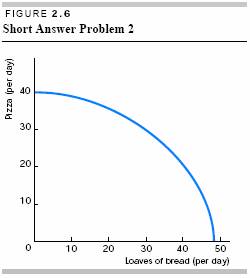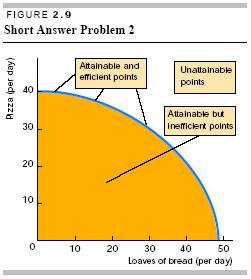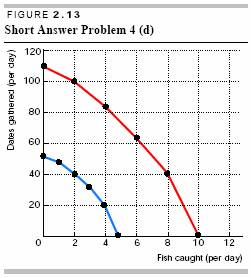
Answers to Short Answer Problems
1. ˇ§In the future, as our technology advances even further, eventually we will whip scarcity. In the high-tech future, scarcity will be gone.ˇ¨ Do you agree or disagree with this claim? Explain your answer and what scarcity is. Why does the existence of scarcity require choices?
Ans. This claim is incorrect. Scarcity will always exist. Scarcity occurs because people's wants are basically unlimited, but the resources available to satisfy these wants are finite. As a result, not all of everyone's wants can be satisfied. For instance, think about the number of people who want to spend all winter skiing on uncrowded slopes. Regardless of the level of technology, there simply are not enough ski slopes available to allow everyone who wants to spend all winter skiing in near isolation to do so. Uncrowded ski slopes are scarce and will remain so. Because not all the goods and services wanted can be produced, choices must be made about which wants will be satisfied and which wants will be disappointed.
2. What are the factors of production? Focusing on the factors of production, describe the relationship between the big microeconomic question ˇ§How are goods and services produced?ˇ¨ and the question ˇ§For whom are goods and services produced?ˇ¨.
Ans. The four factors of production are land, labor, capital, and entrepreneurship. These are the resources used to produce goods and services, so the question asking how goods and services are produced asks which factors will be used. People earn their incomes by offering factors of production for use. Land earns rent, labor earns wages, capital earns interest, and entrepreneurship earns profit. The answer to the question asking for whom the goods and services are produced depends on people's incomes. So, for example, if more land is used to produce goods and services, then landowners' incomes will be higher so they will be able to acquire more of the goods and services that have been produced.
3. How do you think the standard of living changes in the different parts of the business cycle?
Ans. The standard of living is the level of consumption that people enjoy, on the average. The level of consumption depends on the amount of goods and services produced. During a business cycle, the standard of living will be lowest at the trough, because production is lowest. It will rise during an expansion and reach its maximum at the peak. During a recession the standard of living will fall.
4. Why does your decision to buy a taco from Taco Bell reflect a tradeoff? Be sure to discuss the role played by opportunity cost in your answer.
Ans. The decision to buy a taco reflects a tradeoff because you have given up your funds in exchange for the taco. The opportunity cost of buying the taco is the highest-valued alternative given up. For instance, suppose that if you had not decided to buy the taco, you would then have used the funds to buy a burger from Burger King. In this case, the opportunity cost of buying the taco is the forgone burger because that is the highest-valued alternative given up.
5. ˇ§Education is a basic right. Just as kindergarten through 12th grade education is free, so, too, should a college education be free and guaranteed to every American.ˇ¨ This statement can be analyzed by using the economic concepts discussed in this chapter to answer the following questions.
a. What would be the opportunity cost of providing a free college education for everyone?
b. Is providing this education free from the perspective of society as a whole?
Ans. a. Even though a college education may be offered without charge (ˇ§freeˇ¨), opportunity costs still exist. The opportunity cost of providing such education is the highest valued alternative use of the resources used to construct the necessary universities and the highest valued alternative use of the resources (including human resources) used in the operation of the schools.
b. Providing a ˇ§freeˇ¨ college education is hardly free from the perspective of society. The resources used in this endeavor would no longer be available for other activities. For instance, the resources used to construct a new college cannot be used to construct a hospital to provide better health care. Additionally, the time and effort spent by the faculty, staff, and students operating and attending colleges has a substantial opportunity cost, namely, that these individuals cannot participate fully in other sectors of the economy. Providing a ˇ§freeˇ¨ college education to everyone is not free to society!
6. What does the negative slope of the PPF mean? Why is a PPF bowed out?
Ans. The negative slope of the PPF indicates that increasing the production of one good means that the production of some other good decreases.
A PPF is bowed out because the existence of non-identical resources creates an increasing opportunity cost as the production of a good is increased. Because resources are not identical, some are better suited for producing one good than another. So when resources are switched from producing items for which they are well suited to producing goods for which they are ill suited, the opportunity cost of increasing the output of these goods rises.
7. In Figure 2.6 indicate which points are production efficient and which are inefficient. Also show which points are attainable and which are not attainable.

Ans. Figure 2.9 shows the efficient/inefficient points and attainable/not attainable points. The attainable but inefficient points are shaded; the attainable and efficient points lie on the PPF itself; and the unattainable points are located beyond the PPF .

8. Sydna is stranded on a desert island and can either fish or harvest dates. Six points on her production possibilities frontier are given in Table 2.2.
a. In Figure 2.7 plot these possibilities, label the points, and draw the PPF .
b. If Sydna moves from possibility c to possibility d , what is the opportunity cost per fish?
c. If Sydna moves from possibility d to possibility e , what is the opportunity cost per fish?
d. In general, what happens to the opportunity cost of a fish as more fish are caught?
e. In general, what happens to the opportunity cost of dates as more dates are harvested?
f. Based on the original PPF you plotted, is a combination of 40 dates and 1 fish attainable?
Is this combination an efficient one? Explain.


Ans. a. Figure 2.10 shows the PPF .

b. Moving from c to d means that the number of fish caught increases by 1 while the number of dates gathered falls from 42 to 32. Catching 1 fish costs 10 dates, so the opportunity cost of the fish is 10 dates. In terms of a formula, the opportunity cost of this fish is:
![]()
c. Moving from d to e indicates that the opportunity cost of the fish is 12 dates: The number of dates gathered falls from 32 to 20 while the number of fish caught increases by 1.
d. As more fish are caught, the opportunity cost of an additional fish rises. In particular, the first fish has an opportunity cost of only 4 dates; the second, 8 dates; the third, 10 dates; the fourth, 12 dates; and the fifth, 20 dates.
e. As more dates are gathered, the opportunity cost of a date rises. Moving from f to e shows that the first 20 dates cost only 1 fish so that the opportunity cost of a date here is _ __ of a fish. Going from e to d , however, makes the opportunity cost of a date _ __ of a fish. This pattern continues so that as more dates are gathered, their opportunity cost increases. Finally, moving from b to a has the largest opportunity cost for a date, 1/4 of a fish.
As parts (d) and (e) demonstrate, there is increasing opportunity cost moving along the PPF . That is, as more fish are caught, their opportunity cost ˇX in terms of foregone dates ˇX increases and as more dates are gathered, their opportunity cost ˇX in terms of foregone fish ˇX also increases. It is these increasing opportunity costs that account for the bowed-outward shape of the PPF .
f. This combination is within the PPF and is attainable. It is inefficient because Sydna could produce more of either or both goods. Therefore she is not organizing her activities as efficiently as possible.
9. If the following events occurred (each is a separate event, unaccompanied by any other event), what would happen to the PPF in Problem 3?
a. A new fishing pond is discovered.
b. The output of dates is increased.
c. Sydna finds a ladder that enables her to gather slightly more dates.
d. A second person, with the same set of fishing and date-gathering skills as Sydna, is stranded on the island.
Ans. a. A new fishing pond increases the number of fish Sydna can catch, but it does not affect the maximum number of dates she can gather. Her PPF shifts generally as shown in Figure 2.11.

b. Increasing her output of dates does not affect the PPF . Sydna might increase her gathering of dates either by moving from a point within the PPF to a point on (or closer to) the frontier or by moving along the frontier. Neither of these actions shifts the PPF .
c. The ladder increases the number of dates that Sydna can gather, but has no effect on the fish hat she can catch. As a result, the maximum umber of dates increases, but the maximum umber of fish does not change. The PPF shifts n the same general pattern as shown in Figure 2.12.

d. Having a second worker on the island boosts both the number of dates that can be gathered and the number of fish that can be caught. If the second person has the same set of skills as Sydna, the PPF shifts out in a ˇ§parallelˇ¨ manner, as illustrated in Figure 2.13. Be sure to note that the scales on the axes in Figure 2.13 are different from those on the axes in Figures 2.10ˇV2.12.

10. A nation produces only pizza and tacos. Table 2.3 shows the marginal benefit and marginal cost schedules for slices of pizza in terms of tacos per slice of pizza.
a. Complete Table 2.3.
b. For the first slice of pizza, after paying the marginal cost, how much marginal benefit ˇX if any ˇX is left?
c. For the second slice, after paying the marginal cost, how much marginal benefit ˇX if any ˇX is left? How does your answer to this question compare to your answer to part (b)?
d. Should the first slice of pizza be produced? Should the second one be produced? Explain you answers, especially your answer about the second slice.
e. In a diagram, draw the marginal benefit and marginal benefit curves. Indicate the quantity of pizza slices that uses resources efficiently.

Ans. a. Table 2.6 shows the answers.

b. For the first slice of pizza, after paying the marginal cost, there is 4.5 of marginal benefit left.
c. For the second slice of pizza, after paying the marginal cost, there is 3.0 of marginal benefit left. After paying the marginal cost, there is less marginal benefit left for the second slice of pizza than for the first. There is less surplus because the marginal benefit of the second slice is less than that of the first slice and the marginal cost the second slice is more than that of the first one.
d. The first slice should be produced because the marginal benefit from the first slice exceeds its marginal cost. The second slice also should be produced for the same reason. As long as the marginal benefit from a slice of pizza exceeds its marginal cost, society benefits if the slice is produced. The ˇ§net benefitˇ¨ from the first slice is more than that of the second slice, but as long as there is a positive net benefit, society benefits.
e. Figure 2.14 shows the marginal cost and marginal benefit curves. Four slices of pizza are the quantity that uses resources efficiently because the marginal benefit from the fourth slice equals its marginal cost. The marginal benefit for any greater quantity of pizza slices is less than the marginal cost of the slice, so producing these units would result in a net loss for society.

11. Bearing in mind the point that resources are limited, explain why is it important for a nation to use its resources efficiently.
Ans. A nation should use its resources efficiently because it has only a limited quantity of them. If resources are used inefficiently, there is waste and fewer of people's wants can be satisfied. By producing efficiently, society ensures that as many of the most important wants, measured by the marginal benefit from the goods that satisfy those wants, are satisfied.